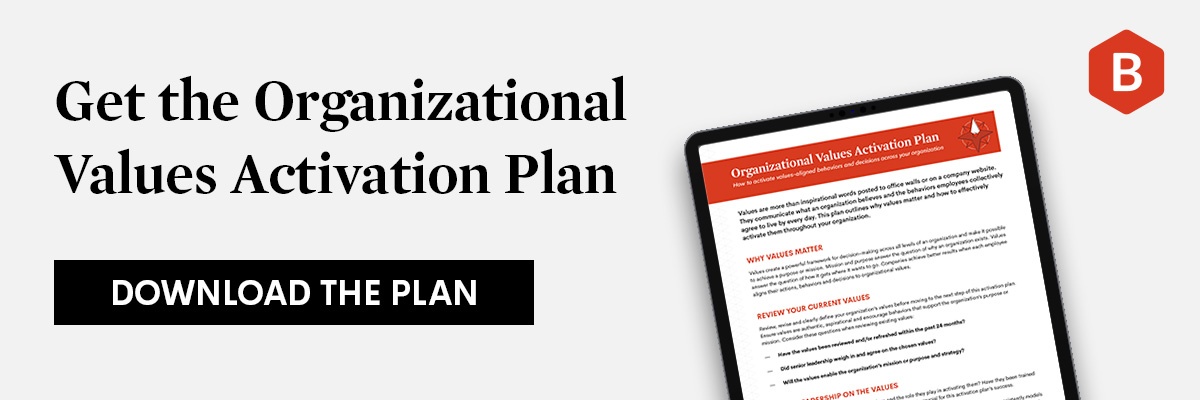Blog
Engaging Employees in Purpose, Mission and Values Through Strategic Communication
|

Blog
Engaging Employees in Purpose, Mission and Values Through Strategic Communication|

Strategic communication is critical to bringing purpose, mission and values to life across an organization. It provides clarity and alignment, establishes expectations and motivates employees to work toward a shared objective. Effective organizations weave purpose, mission and values into ongoing strategic communication initiatives.
Purpose or mission defines why the organization exists and for which stakeholder groups it’s focused on delivering an impact. Values set expectations for how employees think, act, make decisions and behave when interacting with customers, colleagues and partners. These critical business elements risk sitting untouched and growing stale in a business plan without strategic communication to support them.
Why communication about purpose, mission and values matters
Strategic communication that engages employees in the company’s purpose, mission and values can increase the speed at which an organization achieves its goals. It can educate, motivate and inspire.
Twenty years of employee engagement research from Gallup shows that for employees to be productive — and working toward what the company is trying to achieve — they need clear communication about the organization’s purpose or mission. Communication should clarify how an employee’s values-aligned mindset, attitude and behavior can help the organization achieve its purpose or mission. Employees are three-and-a-half times more engaged when they understand how their work contributes to the organization achieving its goals. High employee engagement leads to better customer experience, productivity, retention and profitability, which are all metrics that affect an organization’s success.
Engaging employees in purpose, mission and values through strategic communication is also important because it:
1. Creates shared understanding
Employees are more productive, motivated and engaged when they understand their employer’s purpose or mission. Yet, fewer than half of employees know what their organization stands for and what differentiates it from competitors. Strategic communication engages employees in the purpose, mission and values by clearly defining what each statement means and why they’re vital to the organization.
Clear, concise and consistent communication about the purpose, mission and values creates a shared understanding of what the organization is working toward, why it’s necessary for business success and the role each employee plays. Organizations should routinely share examples of their purpose or mission in action, report to employees on their progress toward the purpose or mission, and create engaging ways for employees to experience the values in action.
2. Aligns leadership
Strategic communication aligns leaders on what’s required to achieve the purpose or mission and activate the values internally and in the marketplace. Aligning an organization to a purpose or mission and supporting values often requires significant organizational changes to business operations and processes. Consistent, clear and frequent communication among leaders makes solving these challenges more manageable.
Leaders should also regularly communicate with employees about the purpose, mission and values. Aligning leaders around key messages ensures clear, consistent language is used so employees can readily identify the purpose or mission and experience the values in action. This is essential to building trust and commitment and to achieving the organization’s purpose or mission. Leadership communication coaching is an effective way to train leaders on how to communicate with employees. Strategic communication keeps leaders involved, committed and effectively engaging with employees about the purpose, mission and values.
3. Inspires employee action
Strategic communication is also needed to activate employee behavior in support of the purpose, mission and values. Organizations that successfully inspire employees use communication to demonstrate the role employees play, how their performance will be measured and to celebrate wins. Employees are significantly more motivated and passionate when they work for organizations that demonstrate and communicate the value they deliver to the world or their stakeholders. Motivated and passionate employees are more loyal to the organization and more likely to use the values to guide daily decisions and actions.
Organizations that successfully use strategic communication to engage employees in purpose, mission and values leverage open, collaborative two-way dialogue. They not only disseminate information to employees but also ask for their feedback through surveys, via focus groups, during annual reviews and on a one-to-one basis. Asking for feedback, then demonstrating that the organization is taking action based on that feedback, builds trust and keeps employees engaged in the success of the organization’s purpose, mission and values.
Organizations can also leverage multiple communication channels and tactics to weave purpose, mission and values throughout the company. These tactics could include company-wide presentations and town hall meetings, new product or service launches, events (e.g., volunteering, celebrations, recognition) and visual representations in the physical office space (e.g., posters in the cafeteria or conference rooms, computer screensavers). Employee activation is more effective and lasting when strategic communication spans various channels and initiatives.
Strategic communication engages employees in purpose, mission and values by providing clarity and alignment and establishing expectations. It increases employee engagement, productivity and motivation. Strategic communication also aligns leadership, activates employees and helps organizations evaluate how well-integrated the purpose, mission and values are across the organization. It’s a critical component in achieving a purpose or mission.
###
About Lisa Hannum, CEO
Lisa Hannum is CEO of Beehive Strategic Communication. She is a purpose-driven leader who believes in the power of communication to build better businesses for a better world and has the vision to see what’s possible, even when the page is blank. Lisa has more than 30 years of experience in brand positioning, change management, culture transformation, crisis management, marketing and public relations. Her ability to turn fresh insights into meaningful connections strengthens businesses in ways that create enduring value. CEOs call her for new perspectives and trust her when the stakes are high.


